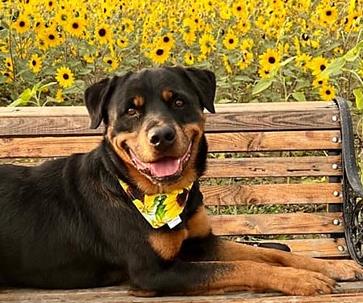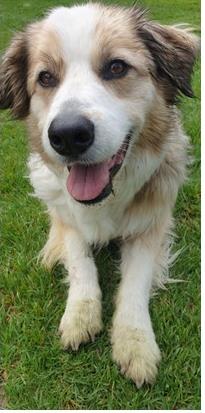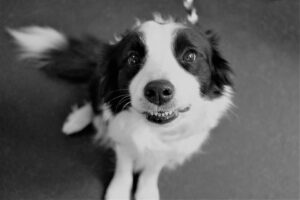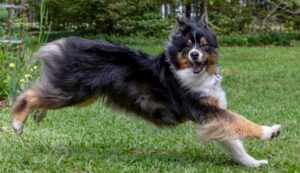“Love your dog first
and the sport second.”
Every now and again this quote makes the rounds on social media. I’ve seen it attributed to various sources. I’m not sure who gets the credit, but I’m always happy to see it shared.
In a sport like freestyle, because the rules are written broadly to encourage creativity, we get to see teams doing some jaw-dropping tricks. And it’s natural to get excited and want to teach your dog to do those things, too. Heck, I’m as guilty as anyone! Sometimes though, what starts out as fun, can quickly lead to frustration for both of you if your dog isn’t ready, isn’t physically capable, or if you don’t have the training skills yet to teach some of those Instagram-worthy behaviors. While Facebook can be an awesome way to connect with fellow freestylers and see what they are working on, what we see (and what we share) is not only the end result but also, often the best.
We are not privy to the process and all of the hard work that led up to that result. So, if you’re feeling pressured to keep one-upping your last routine or feeling defeated because your dog’s heeling isn’t as flashy as someone else’s, this newsletter is for you! Read on for some tough love, a little perspective, and a lot of appreciation for the wonderful canine companions we share our lives with.

Love Your Dog First
7 Truths About Training
and Competing with Our Dogs
 1. Your relationship is everything. What’s the first thing you taught your dog? Before sit or down or come, we teach our dogs how much fun it is to be with us! We take their initial enthusiasm and we optimize it. We get down on the ground and play and give cookies and pets and praise! We want our dogs to love being near us and spending time with us. We build a bond. We create a positive conditioned emotional response to our dogs seeing us, being with us, and training with us.
1. Your relationship is everything. What’s the first thing you taught your dog? Before sit or down or come, we teach our dogs how much fun it is to be with us! We take their initial enthusiasm and we optimize it. We get down on the ground and play and give cookies and pets and praise! We want our dogs to love being near us and spending time with us. We build a bond. We create a positive conditioned emotional response to our dogs seeing us, being with us, and training with us.
If you’ve invested the time and you have a positive relationship, your partner is going to be excited to do new things with you. She’s going to try her hardest to do what you ask of her. Remember this. Praise her efforts! Make things easier if she’s struggling. Set her up for success. Don’t sully what you have built by rushing to try to keep up with someone else. Remember, you can’t recreate initial enthusiasm. Training and performing together can forge a beautiful bond or it can derail one. Pay attention to how your goals may be affecting your relationship with your dog.
2. Learning should be fun. Know how your dog learns and make training an activity they look forward to! Too much pressure or drilling can spoil your dog’s joy. It doesn’t matter how much fun the behavior you’re teaching is if the methods you’re using aren’t compatible with your dog’s personality, learning style, and preferences. Being insistent or always asking for more is effective with some dogs but can have lasting consequences for others.
 You are responsible for your dog’s attitude toward freestyle, or Rally-FrEe, or training in general. Participating in a sport with you should make your dog feel like it’s their birthday! They’re getting you all to themselves for that little slice of time. The treat store is open. Reinforcers are available. They get to show off for you. Seriously, we should make them feel like they’ve won the Lotto! Guard against poisoning training or the ring by being stressed, distracted, unprepared, disappointed, pressured, unrealistic – any number of conscious or unconscious reasons.
You are responsible for your dog’s attitude toward freestyle, or Rally-FrEe, or training in general. Participating in a sport with you should make your dog feel like it’s their birthday! They’re getting you all to themselves for that little slice of time. The treat store is open. Reinforcers are available. They get to show off for you. Seriously, we should make them feel like they’ve won the Lotto! Guard against poisoning training or the ring by being stressed, distracted, unprepared, disappointed, pressured, unrealistic – any number of conscious or unconscious reasons.
Our dogs’ feelings about the sport are up to us. So, let the treats flow, and the toys fly! Don’t be stingy. Be happy! Withhold judgment. Enjoy the experience. Savor that magical feeling of being in unison (or InSync 😉). Do more of the things they enjoy: send-outs, circles, jumping. Incorporate reinforcing behaviors into your training and performances. And remember to give them time to rest their bodies and minds.
Only you can make freestyle or Rally-FrEe their favorite activity. Your partner is much more than his performance. Your pup just wants to have fun with you. He didn’t choose to walk around doing tricks at 15 signs or to do 100 behaviors while you wave your arms around to music. He’s just as  happy playing ball with you at home.
happy playing ball with you at home.
So remember, you’re not brokering world peace, you’re participating in a game that you chose to play. If either of you isn’t having fun, take a break and assess why that is. Then either go back to training freestyle, or Rally-FrEe or whatever the sport, possibly with some changes, or determine if there is something else you would both enjoy instead.
 3. Take the feedback you’re given. Do the fancy tricks, but observe your dog’s body language and demeanor. Watch for his joy. Know what it looks like. If you’re not seeing confidence and enthusiasm, he may not be ready for the next step, or you may need to change your approach. If you see reluctance, sniffing, distraction or displacement behaviors, he’s telling you something! Listen to his feedback. If his body language and demeanor say he’s not ready and he’s feeling pressured and you try to push through, you might get what you’re after, or he might opt out altogether. Remember you’re shaping his attitude toward training. Pay attention to his signals and make adjustments based on his responses.
3. Take the feedback you’re given. Do the fancy tricks, but observe your dog’s body language and demeanor. Watch for his joy. Know what it looks like. If you’re not seeing confidence and enthusiasm, he may not be ready for the next step, or you may need to change your approach. If you see reluctance, sniffing, distraction or displacement behaviors, he’s telling you something! Listen to his feedback. If his body language and demeanor say he’s not ready and he’s feeling pressured and you try to push through, you might get what you’re after, or he might opt out altogether. Remember you’re shaping his attitude toward training. Pay attention to his signals and make adjustments based on his responses.
4. Let your pup set the pace. If you feel rushed or like you have to do more because you’re falling behind, your pup will feel that stress, too.
And being far wiser than we are at times, your dog is going to avoid the cause of the stress. “I think I’ll go over here and sniff” – No training, no stress. You don’t have to train all the things now. So Felicia Freestyler posted her 6-month-old dog Fifi on Facebook doing the Turn Back Thru three different ways. Brava, Fifi! That’s awesome. But it’s not necessary. Your journey is your own. Your pup’s perfect paw lift is also awesome! Celebrate it!

And if Felicia and Fifi inspire you, follow them! Celebrate with them! And share what you are working on so they too can celebrate with you! If it’s that Turn Back Thru you want, then make it your next training project. Take the time it takes for your dog to fully understand and enjoy a newly trained behavior. Be patient while your dog’s confidence and understanding build. Take time, be consistent and be patient.

5. Know what you want. A Q, a Facebook photo, panache, synchronicity, precision? What do you want? Not what other people expect. Not what your instructor or your classmates or your followers want. In your heart, what do you want for yourself and your dog? Picture it clearly. Commit to it. Break it down into individual components and train each piece to fluency. That’s the only way to get there. There are no shortcuts and there isn’t a one size fits all plan. Be honest about where your dog is. Start there and enjoy the journey together.

6. It Doesn’t Happen Overnight. Part of taking responsibility as handlers and trainers is being willing to put in the time and do the work. If someone tells you that it was easy to get their dog to step high and prance beautifully by their side in front of an audience in a new environment, that team is the exception, not the rule. A seemingly effortless performance takes a lot of time and work. Being at one with your dog requires an investment. So, if that’s what you want, be prepared to put in the time and work hard. Is it worth it? That’s up to you. No one else can decide if all of the hours, effort, dollars, highs and lows are worth it. But if you do decide to put in the work as a trainer, to dedicate the time as a teammate, to do the job of a handler; if you decide to commit as many months or years as it takes, remember why you’re doing it – the relationship, self-discovery, a happy dog, a bond. Like all great things in life, more often than not, they don’t come easily or quickly. It takes as long as it takes.
 7. Be present. Savor where you are. Celebrate your progress. Your training may not look like much to anyone else. Unless you’re at the point where you’re working on blind sidepasses or extreme distance moves, observers may think you’re boring. Who cares? Let them train their dogs and you train yours. Find joy in being the best team you can be right now. Enter the events. Invite criticism. Use all of it to grow, laugh and learn together.
7. Be present. Savor where you are. Celebrate your progress. Your training may not look like much to anyone else. Unless you’re at the point where you’re working on blind sidepasses or extreme distance moves, observers may think you’re boring. Who cares? Let them train their dogs and you train yours. Find joy in being the best team you can be right now. Enter the events. Invite criticism. Use all of it to grow, laugh and learn together.
Take pictures. Record video. You don’t need to be Insta-Ready. Love who you are and what you’re becoming together. Acknowledge your trust in one another. Make memories. Don’t wait until you reach perfection. Embrace mediocre while you improve. Be proud of all of the work you’ve done and welcome the work that remains. And while it may sound cliché, more than anything else, find the joy in the journey. Because there is no end to what you and your dog can accomplish together.

